Sport and Vintage Aviation Society Airshow for 2005
It was an overcast but otherwise sunny and warm day in January when the
NZ Sport and Vintage Aviation Society
(abreviated S.V.A.S. from here on). held their bi-annual airshow. This
year it was held at their aerodrome in the Wairarapa on Saturday 22nd
and Sunday 23rd. They have a roster for these shows with it alternating
around the country to a different airfield so that the entire country
gets an airshow near them on a regular basis. The S.V.A.S. have been
doing these shows for a while now and their experience shows at many
levels throughout the show.
The first indication of this came as Ewen and I arrived in his car to
the showgrounds. Traffic had been directed in an orderly fashion to the
two entrances and parking space had been allocated in various fields
situated next to the aerodrome. Continuing their organisational prowess
the traffic was neatly directed to their parking spot so that the fields
filled in an orderly fashion and everyone had clear room to get into and
out of their cars. It was nicely done and much better than the usual
rugby scrum [1] approach many volunteer groups use
to handle parking.
Once parked it was a moderate walk over the fields to the entrance
proper of the aerodrome. At the time we arrived the show had already
begun and we could see the early World War 1 Fokker planes flying
overhead. The show had a timetable that you could download and print off
indicating the order of the days events and they stuck very closely to
the outlined timetable. Sadly the presense of the planes flying slowly
overhead, these planes travel so slowly they almost seem to drift idly
across the sky rather than actually fly purposefully, meant I made quite
the big mistake for the day. I spent my time looking up and not
concentrating on where I was going.
The astute reader will know exactly what is coming next. Yep, I put
my foot down badly and managed to fall over twisting my ankle nicely.
Fortunately not enough to do permanent damage or break anything but
plenty enough to put a painful crimp on movement for next few days. This
meant any thoughts I might have had about wandering around the parked
planes being exhibited went right out the window. As did any thought of
maneuvering about to get a good shot of the various aerobatics. Ewen and
I ended up plonking ourselves down near the runway behind a wire fence
that gave us a good view of the planes taking off and taxiing. We also
ended up getting a good look at the servicing and preperation of the
planes especially the two Vampire jets we were situated behind.
Thus if you see wire in the foreground of my photographs - that is
why. It simply was too painful to get up and get to someone where I'd get
a clear line of sight. I did try to compensate for this by focusing past
the fence and it was bright enough that I could get away with shallower
depths of field thanks to the wide apetures. Even so it crops up in a few
images here so my apologies, my foot asks your indulgence here. The other
factor complicating matters was the somewhat rude crowd of children and
parents who, despite a very large and obvious camera featuring on my part
and Ewen having his out as well we kept getting people pushing in front
of us or shaking the fence making it hard to poke the lense between the
wires to try and get one layer of the wire fencing out of the
shot. [2] I'd be happier to tolerate this without
any complaint if I was shooting with a digital camera but when each shot
taken costs to get it developed then it rapidly becomes very irritating.
It took some direct and pointed requesting that people stop mucking about
with the fence to get the point across but eventually we got them to stop.
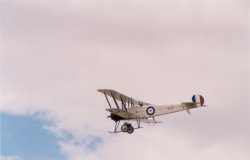 Fortunately such anti-social behavior was not the norm and generally
the crowd spent a pleasant time watching the planes go through their
paces. Well apart from the hat and umbrella clearing blast we got from
certain elderly jets warming up, but I am getting ahead of myself. Thanks
to the foot twisting by the time I limped into position and then got my
camera out then the Fokkers had largely finished their gentle gliding
across the sky. I did get this nice shot of a
British Avro 504K as
it wandered overhead. The amazing thing with the older planes is, being
used to jets and faster prop planes, just how slowly they move through
the air. They seem almost to hang in the air using skyhooks to hold them
up. It doesn't help that their engines are also pretty quiet so once they
get a few hundred feet up they become background gnats noisewise - angry
moths doing slow maneuvers over the airfield. I rather imagine it's a bit
more of an exciting and white knuckle ride for the pilots than it appears
from the ground.
Fortunately such anti-social behavior was not the norm and generally
the crowd spent a pleasant time watching the planes go through their
paces. Well apart from the hat and umbrella clearing blast we got from
certain elderly jets warming up, but I am getting ahead of myself. Thanks
to the foot twisting by the time I limped into position and then got my
camera out then the Fokkers had largely finished their gentle gliding
across the sky. I did get this nice shot of a
British Avro 504K as
it wandered overhead. The amazing thing with the older planes is, being
used to jets and faster prop planes, just how slowly they move through
the air. They seem almost to hang in the air using skyhooks to hold them
up. It doesn't help that their engines are also pretty quiet so once they
get a few hundred feet up they become background gnats noisewise - angry
moths doing slow maneuvers over the airfield. I rather imagine it's a bit
more of an exciting and white knuckle ride for the pilots than it appears
from the ground.
The general organisation of the airshow was to work chronologicaly
through the aircraft starting with pre-WWI era aircraft, WWI planes, then
on to the WW2 planes before finally unleashing the jets to deafen us all.
Mixed in were acrobatic displays around lunch time, a special appearance
from NZ military teams and finally to round the day off a mock airfield
raid complete with air and ground defences. This nicely mixed up the day
and an especially good feature was the running commentary provided by a
variety of people over the loudspeaker system during the day. Care was
taken to keep the speaker relavent to the planes flying and they often
had informative details to relate about the history of the planes
featured, their capabilities and quirks. Again a nice touch indicative of
the level of organisation present throughout the show.
Anyhoo once the World War I planes settled back to the ground it
became the inter-war period planes turn to shine above the airfield. One
side effect that was interesting was the flight ceilings used by the
planes. The World War I era planes tended to keep pretty close to the
ground but as the power and maneuverability of the planes increased the
flight ceiling kept rising as the speeds involved forced wider turns -
despite the newer planes being more agile. At this point in the
proceedings the planes were still moderately low to the ground and a lot
of their aerobatics were taking place behind a set of large staff tents,
thus the large number of taxiing photographs you are going to see for the
next few planes. Well that and the few shots I did get of the aerobatics
weren't particularly exciting.
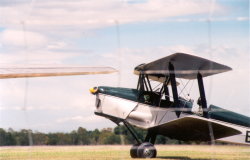
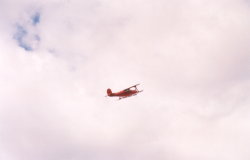 First off we had the classic shape of the
de Havilland DH82 Tiger Moth,
with a pair of them doing aerobatics. Anyone who has read the Biggles
novels gets goosebumps looking at these sturdy old planes, although
Biggles flew a Sopwith Camel not a Tiger Moth - one of those featured in
the WWI flybys so it was all good. Also featured was a
Beechcraft 17S Staggerwing,
which I have to say is not a plane I was aware of to any great degree.
Certainly it flies well though and while the photograph here is a little
dull the plane put on a great performance dancing across the field very
nimbly. If you follow the link above you can see that this plane, like
many pre-World War II planes were the product of an inspired and
dedicated designer who pushed the design ahead despite the objections or
obstacles raised.
First off we had the classic shape of the
de Havilland DH82 Tiger Moth,
with a pair of them doing aerobatics. Anyone who has read the Biggles
novels gets goosebumps looking at these sturdy old planes, although
Biggles flew a Sopwith Camel not a Tiger Moth - one of those featured in
the WWI flybys so it was all good. Also featured was a
Beechcraft 17S Staggerwing,
which I have to say is not a plane I was aware of to any great degree.
Certainly it flies well though and while the photograph here is a little
dull the plane put on a great performance dancing across the field very
nimbly. If you follow the link above you can see that this plane, like
many pre-World War II planes were the product of an inspired and
dedicated designer who pushed the design ahead despite the objections or
obstacles raised.
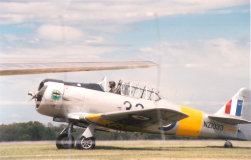
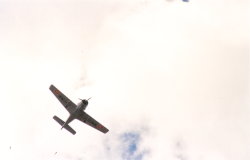 We then had various trainer aircraft put through their paces. Most
memorable, or perhaps best photographed of the lot, was the
North American Harvard
seen here taxiing and overflying the field. This proceeded to put on an
aerobatics display and I believe one was fitted with a gas gun simulator
allowing it to stage mock attacks as part of the maneuvers conducted.
This sounded less like a gun firing and more akin to the plane suffering
from a chronic case of flatulence. But still, it spiced up the display so
I should be a touch kinder about it. In some ways the presence of the gas
simulator fits the primary roles these planes filled - that of trainers.
So having one of the examples here simulating an attack on the airfield
seems just so fitting.
We then had various trainer aircraft put through their paces. Most
memorable, or perhaps best photographed of the lot, was the
North American Harvard
seen here taxiing and overflying the field. This proceeded to put on an
aerobatics display and I believe one was fitted with a gas gun simulator
allowing it to stage mock attacks as part of the maneuvers conducted.
This sounded less like a gun firing and more akin to the plane suffering
from a chronic case of flatulence. But still, it spiced up the display so
I should be a touch kinder about it. In some ways the presence of the gas
simulator fits the primary roles these planes filled - that of trainers.
So having one of the examples here simulating an attack on the airfield
seems just so fitting.
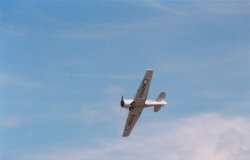
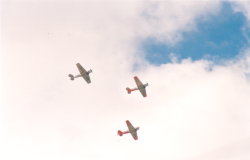 Perhaps most unusual about these planes was the forward folding landing
gear that while rendering the plane more streamlined for flight do look a
little odd in the way the leading edge of the wing starts with wheels. I
can't say I have seen that on aircraft before and it lends the Harvard a
distinctive visual marker - not that this helped me when I was putting
this page together. I managed to completely confuse the Yak52 and the
Harvard 2A for half of the photographs featured here. It was only the
clear Civial Aviation Authority registration number on the wings of one
of the planes that clued me into my mistake - I saw the registration
number listed against a very different plane type than I had expected.
Perhaps most unusual about these planes was the forward folding landing
gear that while rendering the plane more streamlined for flight do look a
little odd in the way the leading edge of the wing starts with wheels. I
can't say I have seen that on aircraft before and it lends the Harvard a
distinctive visual marker - not that this helped me when I was putting
this page together. I managed to completely confuse the Yak52 and the
Harvard 2A for half of the photographs featured here. It was only the
clear Civial Aviation Authority registration number on the wings of one
of the planes that clued me into my mistake - I saw the registration
number listed against a very different plane type than I had expected.
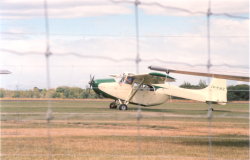
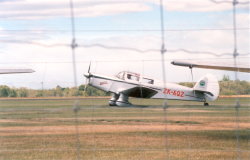 Next up was a tribute to Edgar Percival who designed a variety of planes
of which three featured in the display. I missed getting a good shot of
the Piston Provost but did get the
EP 9
as seen here and the
Proctor a little
further down. The EP 9 is a very distinctive shape and has a remarkably
quick take off and landing span required. The pregnant guppy looks belies
its original cargo and crop spraying design. I have to say while the name
of Edgar Percival may mean a lot to aviation enthusiasts the planes
themselves aren't wildly recognisable to me. The Proctor is a remarkably
modern looking for a plane its age and this is no doubt the point of
featuring Mr Percival's work - it has been influential to a large degree.
Next up was a tribute to Edgar Percival who designed a variety of planes
of which three featured in the display. I missed getting a good shot of
the Piston Provost but did get the
EP 9
as seen here and the
Proctor a little
further down. The EP 9 is a very distinctive shape and has a remarkably
quick take off and landing span required. The pregnant guppy looks belies
its original cargo and crop spraying design. I have to say while the name
of Edgar Percival may mean a lot to aviation enthusiasts the planes
themselves aren't wildly recognisable to me. The Proctor is a remarkably
modern looking for a plane its age and this is no doubt the point of
featuring Mr Percival's work - it has been influential to a large degree.
_Half.jpg) One of the major highlights of the day for me was the presence of a
Douglas 'Dakota' DC3.
I've read a fair bit about these planes, watched the odd documentary
about their creation and even seen a fair number of TV series & films
where they feature prominently. Even with all that I wasn't prepared for
the noise the plane made. The engines on this DC3 were very recognisable
producing the droning humm that many a film has depicted. What the films
don't convey well is the strength of that humm. One Dakota was loud
enough, I can scarcely begin to even imagine what the 2,000 odd, that
featured in the early stages of D-Day shuttling the troopers of the 101st
airborne paratroopers across the English Channel, must have been like.
Contemplating what that sounded like for the German forces they flew over
is interesting, it must have been an awe inspiring and probably
terrifying experience. Here I managed to capture the DC3 in flight
replicating remarkably well the cover artwork of Mike Oldfield's album
'Five Miles Out'.
One of the major highlights of the day for me was the presence of a
Douglas 'Dakota' DC3.
I've read a fair bit about these planes, watched the odd documentary
about their creation and even seen a fair number of TV series & films
where they feature prominently. Even with all that I wasn't prepared for
the noise the plane made. The engines on this DC3 were very recognisable
producing the droning humm that many a film has depicted. What the films
don't convey well is the strength of that humm. One Dakota was loud
enough, I can scarcely begin to even imagine what the 2,000 odd, that
featured in the early stages of D-Day shuttling the troopers of the 101st
airborne paratroopers across the English Channel, must have been like.
Contemplating what that sounded like for the German forces they flew over
is interesting, it must have been an awe inspiring and probably
terrifying experience. Here I managed to capture the DC3 in flight
replicating remarkably well the cover artwork of Mike Oldfield's album
'Five Miles Out'.
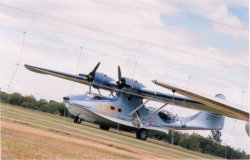 Sharing engine types with the DC3 is the
Consolidated PBY-5A Catalina
- a venerable flying boat design that reminded me of my grandmother
describing flying boats operating out of Wellington Harbour. A much
slower and a touch more ponderous craft than the DC3 it was nonetheless a
pleasure to see one of these in flight. The pilot did multiple passes,
some with the outrigger amphibious floats lowered to show the profile the
plane would take when landing on water. Thanks to its amphibious
capabilities, relatively good observer visbility from various bubbles and
a decently long range (3,782 km odd) many of these planes served as
search and rescue units. No doubt many a grateful pilot was very glad to
see one of these almost ungainly planes coming down to land and pluck
them from the water.
Sharing engine types with the DC3 is the
Consolidated PBY-5A Catalina
- a venerable flying boat design that reminded me of my grandmother
describing flying boats operating out of Wellington Harbour. A much
slower and a touch more ponderous craft than the DC3 it was nonetheless a
pleasure to see one of these in flight. The pilot did multiple passes,
some with the outrigger amphibious floats lowered to show the profile the
plane would take when landing on water. Thanks to its amphibious
capabilities, relatively good observer visbility from various bubbles and
a decently long range (3,782 km odd) many of these planes served as
search and rescue units. No doubt many a grateful pilot was very glad to
see one of these almost ungainly planes coming down to land and pluck
them from the water.
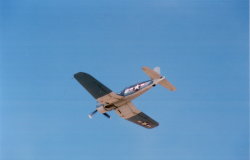 After the Catalina a 'lunch' break featured with a variety of smaller
remote controlled aircraft providing displays. One of the more unusual
was a 1/6th scale A-10 Warthog replica which kept the crowd decidedly
amused as it jetted around. Only having fuel for something like eight
minutes of flight its display was short and to the point. Having given
everyone a chance to get food the display resumed with a mock airfield
attack of World War II era planes. One of the biggest crowd pleasers
present was the
Corsair
as well as a P51D Mustang - a plane which I totally failed to capture any
decent photographs of. But the Corsair was quite spectacular first
featuring in a mock raid on the airfield and then having it's own
aerobatics display. The shear physical presence of the plane is hard to
state. The Mustang, while a remarkable and agile plane, was almost
reserved in feel compared to the loud growling of the Corsair. The
Corsair was, bar the jet aircraft, simply the loudest aircraft in the
display. It's huge propeller span and crooked wing profile made it
instantly recognisable and very easy to follow as it put on an excellent
display. Swooping from a thousand feet or so up it pulled out just as the
characteristic wail of the air intakes was really getting going and then
proceeded to do several low flyovers. Unlike any other plane of the
display you didn't so much hear the Corsair go overhead as feel it, the
plane leaving a strong shockwave behind it of both disturbed air and
simple engine noise.
After the Catalina a 'lunch' break featured with a variety of smaller
remote controlled aircraft providing displays. One of the more unusual
was a 1/6th scale A-10 Warthog replica which kept the crowd decidedly
amused as it jetted around. Only having fuel for something like eight
minutes of flight its display was short and to the point. Having given
everyone a chance to get food the display resumed with a mock airfield
attack of World War II era planes. One of the biggest crowd pleasers
present was the
Corsair
as well as a P51D Mustang - a plane which I totally failed to capture any
decent photographs of. But the Corsair was quite spectacular first
featuring in a mock raid on the airfield and then having it's own
aerobatics display. The shear physical presence of the plane is hard to
state. The Mustang, while a remarkable and agile plane, was almost
reserved in feel compared to the loud growling of the Corsair. The
Corsair was, bar the jet aircraft, simply the loudest aircraft in the
display. It's huge propeller span and crooked wing profile made it
instantly recognisable and very easy to follow as it put on an excellent
display. Swooping from a thousand feet or so up it pulled out just as the
characteristic wail of the air intakes was really getting going and then
proceeded to do several low flyovers. Unlike any other plane of the
display you didn't so much hear the Corsair go overhead as feel it, the
plane leaving a strong shockwave behind it of both disturbed air and
simple engine noise.
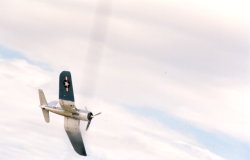
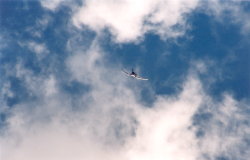
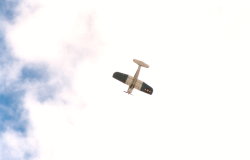
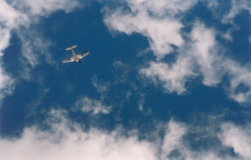 As can be seen in the photographs by this point in the day the early
cloud cover had lightened to provide patches of blue sky - giving the
Corsair frequent chances to briefly disappear on the high end of the
loops and rolls performed. The sky blue colouring working remarkably
well. Of course these was no mistaking that the plane was around, the
engine noise never let you forget that and I can see how soldiers on the
ground facing one of these machines could be intimidated by it. It was
definitely a lot of fun to see this plane put through its paces.
As can be seen in the photographs by this point in the day the early
cloud cover had lightened to provide patches of blue sky - giving the
Corsair frequent chances to briefly disappear on the high end of the
loops and rolls performed. The sky blue colouring working remarkably
well. Of course these was no mistaking that the plane was around, the
engine noise never let you forget that and I can see how soldiers on the
ground facing one of these machines could be intimidated by it. It was
definitely a lot of fun to see this plane put through its paces.
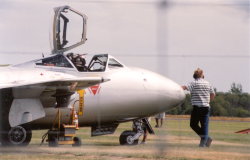 After the Yak 52s and Nanchangs strutted their stuff it came the turn of
the Jets to begin. First to warm up was a venerable
deHavilland DH115 T.55 Vampire
which required a little battery assistance to get it going. I have a soft
spot for these planes having been raised on Gerry Anderson TV shows when
I was a kid - the Vampire just looks like it stepped out of a
Thunderbirds model workshop with its' curved and unusual shape. Amusingly
enough it was also the plane that created the most havoc amongst the
group of spectators we were in because of it's backwash when spooling the
engine up. The Vampires required a gentler wind up with time for the
engine to adjust to the heat and stresses involved - all of which meant
some consternation as hats and umbrellas were scattered a bit during this
process. That and the heavy wash of kerosene as the engine whined it's
way up to power. Once in the air all the effort of getting the two
Vampires on display was forgotten with the planes putting on several
graceful arcing maneuvers over the airfield.
After the Yak 52s and Nanchangs strutted their stuff it came the turn of
the Jets to begin. First to warm up was a venerable
deHavilland DH115 T.55 Vampire
which required a little battery assistance to get it going. I have a soft
spot for these planes having been raised on Gerry Anderson TV shows when
I was a kid - the Vampire just looks like it stepped out of a
Thunderbirds model workshop with its' curved and unusual shape. Amusingly
enough it was also the plane that created the most havoc amongst the
group of spectators we were in because of it's backwash when spooling the
engine up. The Vampires required a gentler wind up with time for the
engine to adjust to the heat and stresses involved - all of which meant
some consternation as hats and umbrellas were scattered a bit during this
process. That and the heavy wash of kerosene as the engine whined it's
way up to power. Once in the air all the effort of getting the two
Vampires on display was forgotten with the planes putting on several
graceful arcing maneuvers over the airfield.
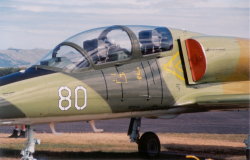 As part of that an Eastern Block plane, the Checkoslovakian made
L-39C Albatross
jet, joined in with the Vampires. All three did a couple of passes over
the airfield. Sadly the very speed of the jets is their own undoing when
it comes maneuvering for displays. The flight ceiling available was
fairly low which limited the faster jets to mostly straight line
manuevers in which less time was spent over the airfield. It is just an
unfortunate reality of the speeds these machines operate at. In most
respects the World War II prop driven planes provided the most exciting
display of the day through having the most powerful and nimble planes
that don't require such a large operating volume to work in. Still it was
very interesting to see the Albatross flying with the Vampires with the
thirty years of design work and refinement between the two plane types
showing in how they maneuvered. The Vampires had to be a touch more
gentle with the power maneuvers as the jet engines in them have to be
treated with a lighter hand. The Albatross, with a much newer engine,
could do flashier moves as a result.
As part of that an Eastern Block plane, the Checkoslovakian made
L-39C Albatross
jet, joined in with the Vampires. All three did a couple of passes over
the airfield. Sadly the very speed of the jets is their own undoing when
it comes maneuvering for displays. The flight ceiling available was
fairly low which limited the faster jets to mostly straight line
manuevers in which less time was spent over the airfield. It is just an
unfortunate reality of the speeds these machines operate at. In most
respects the World War II prop driven planes provided the most exciting
display of the day through having the most powerful and nimble planes
that don't require such a large operating volume to work in. Still it was
very interesting to see the Albatross flying with the Vampires with the
thirty years of design work and refinement between the two plane types
showing in how they maneuvered. The Vampires had to be a touch more
gentle with the power maneuvers as the jet engines in them have to be
treated with a lighter hand. The Albatross, with a much newer engine,
could do flashier moves as a result.
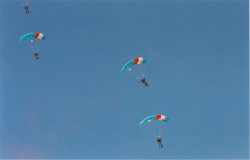 After the jets finished it became the turn of the RNZAF to strut their
stuff. First off was a flyover of airfield by an Orion from which a team
of AirForce skydivers proceeded to drop in on the show. It was a nicely
executed parachute drop landing pretty close to the aim point designated.
That was then followed by what was described as "NZ's counter terrorism
asset", yes that was singular. One Iroquois helicopter which proceeded to
do several flybys of the field. I tried to get a few photographs of it
but most of my efforts came out as fairly dull shots. What Ewen and I
spent a bit of time chuckling about was the thought that any terrorist
operating in New Zealand hopefully didn't think to pack any surface to
air missiles or our counter-terrorism asset is kinda in trouble...
After the jets finished it became the turn of the RNZAF to strut their
stuff. First off was a flyover of airfield by an Orion from which a team
of AirForce skydivers proceeded to drop in on the show. It was a nicely
executed parachute drop landing pretty close to the aim point designated.
That was then followed by what was described as "NZ's counter terrorism
asset", yes that was singular. One Iroquois helicopter which proceeded to
do several flybys of the field. I tried to get a few photographs of it
but most of my efforts came out as fairly dull shots. What Ewen and I
spent a bit of time chuckling about was the thought that any terrorist
operating in New Zealand hopefully didn't think to pack any surface to
air missiles or our counter-terrorism asset is kinda in trouble...
If you are interested Ewen has his collection of photographs
online,
which includes a few shots of the Iroquois doing its stuff. These
helicopters have been a staple of Airforce/Army work all around New
Zealand and have proved to be pretty durable and dependable machines.
Well aside from the odd scandal when buying reconditioned rotor blades
that weren't reconditioned properly - hardly the machine's fault. Still
the sound of these helicopters is fairly distinctive and I suspect a
large proportion of New Zealand's populace is very familiar with that
noise as they often aid in search and rescue operations for missing
trampers.
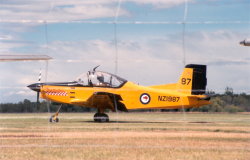
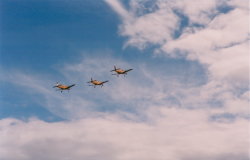
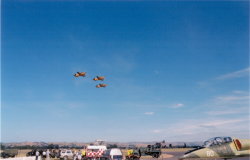
Another portion of the display that the RNZAF put on was the Red
Checkers aerobatics team doing formation flying and a variety of stunt
manuevers. These guys were very polished and sadly my photographs of them
don't really reflect the skill and precision with which they flew. What
wasn't helping was unfamiliarity with the maneuvers being performed so
that by the time I had the camera focused in the right place to take the
shot it was usually far too late. If I had been using a Digital camera I
would have been far happier to just snap away in rapid fire to try and
capture the moment. But I had only a limited number of film rolls with me
and I was trying to conserve a roll for the finale sequence of the show,
I expected that to be pretty dramatic. You can also see in some of the
shots here I decided it was sunny enough to warrant sneaking the
polarising filter out to give the colours a lift. Again it is tricky to
use that filter well with a rapidly moving target as they are very
sensitive to the angle the subject is relative to the direction of the
sunlight.
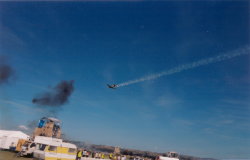
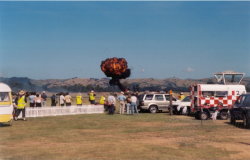
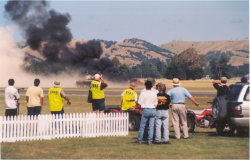
This brought us to the grand finale of the day - the airport attack.
Various fighters, all WW2 vintage, staged a mock assault on the airfield.
Carefully positioned dummy explosives then produced billowing clouds of
smoke and pyrotechnic noise as the attackers pressed the assualt.
Naturally, this being a pretend WW2 airbase, the defenders came to meet
the challenge with the first response being on the ground as WW2 era
tanks and vehicles moved into position to provide anti-aircraft fire.
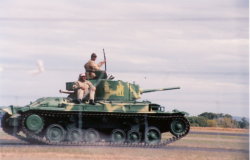 Quite a variety of vehicles came out for the display including a couple
of WW2 era tanks. The announcer commented that airshows is pretty much
one of the few times the tank owner gets a chance to drive the vehicle as
it has a huge appetite for fuel. Also present were a variety of trucks,
jeeps for command staff and a couple of heavy machine gun half-track
vehicles originally intended to provide anti-aircraft fire. This
collection of vehicles proceeded across the field while a healthy number
of defending aircraft proceeded to challenge the attackers - providing
another opportunity for the gas gun simulator to find use.
Quite a variety of vehicles came out for the display including a couple
of WW2 era tanks. The announcer commented that airshows is pretty much
one of the few times the tank owner gets a chance to drive the vehicle as
it has a huge appetite for fuel. Also present were a variety of trucks,
jeeps for command staff and a couple of heavy machine gun half-track
vehicles originally intended to provide anti-aircraft fire. This
collection of vehicles proceeded across the field while a healthy number
of defending aircraft proceeded to challenge the attackers - providing
another opportunity for the gas gun simulator to find use.
Now I may have this back to front but I think the Valentine tank was
supporting the attacking squadron of Yaks and Nanching's while a
defending squadron of the Corsair, P51 Mustang and two Harvards flew to
deal with the attackers. The defenders being supported by an extra tank
to deal with the Valentine and a variety of support vehicles including
medical trucks, half-track heavy machine gun mounts for AA fire and
Jeeps. It actually was quite surprising how many vintage vehicles were
available for the display given that a great many of them are just
personally owned by residents of the Wairarapa region. There obviously is
a healthy community of WW2 militaria afficionados who seem to get a great
kick out of driving them any chance they get.
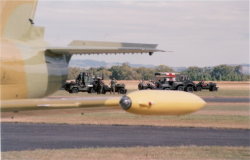
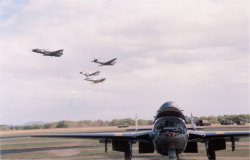
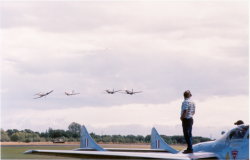
It all made for a suitably dramatic and fun conclusion to the
airshow.
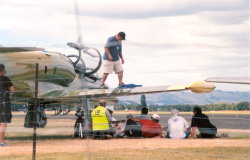 In the odds and ends segment the clouds clearing to let the sun through
produced some more unorthodox methods of finding shade. Always nice to
know the specially imported and no doubt expensive Checkoslovakian jet
makes such a perfect improtu umbrella. In fact the crew that flew the
remote controlled A-10 Warthog spent a fair bit of time poddling around
near the L-39C as well, often nipping under the wings to get away from
the sunshine.
In the odds and ends segment the clouds clearing to let the sun through
produced some more unorthodox methods of finding shade. Always nice to
know the specially imported and no doubt expensive Checkoslovakian jet
makes such a perfect improtu umbrella. In fact the crew that flew the
remote controlled A-10 Warthog spent a fair bit of time poddling around
near the L-39C as well, often nipping under the wings to get away from
the sunshine.
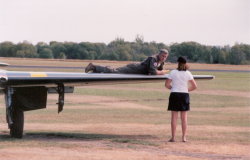 Also in the unorthodox use of jets category was the surprise revelation
that a Vampire wing is apparently extremely comfortable. No doubt a line
of lounge furniture will be forthcoming - think of the novelty roast food
you could prepare off the jet engine while your guests enjoy wingtip
sartorial comfort! Well maybe not - the cost in jet fuel for a properly
cooked sausage might be a touch prohibitive not to mention the issue of
avoiding setting your lounge alight...
Also in the unorthodox use of jets category was the surprise revelation
that a Vampire wing is apparently extremely comfortable. No doubt a line
of lounge furniture will be forthcoming - think of the novelty roast food
you could prepare off the jet engine while your guests enjoy wingtip
sartorial comfort! Well maybe not - the cost in jet fuel for a properly
cooked sausage might be a touch prohibitive not to mention the issue of
avoiding setting your lounge alight...
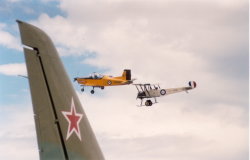 But perhaps the photograph for me that summed up the airshow would be
this one. In it three generations of powered flight share the field of
view giving you a snapshot of the line of development that aviation has
undergone. This to me is what it was all about, seeing that lineage and
understanding just how far aviation really has come. Not to mention to an
extent how short a time it has all happened in. It can be easy to forget
that the days of no aviation at all are only just begining to pass out of
living memory which is where shows like these really become important, I
can remember my grandmother talking of the days when flying arrived in
the first place and her thrill at taking a ride for the first time in a
biplane. Having seen the frailty of the very first planes it gives you a
better appreciation of why people could so easily underestimate the
effect the airplane was going to have on shaping the world we know today.
It also can be easy to mistake these airshows as being purely about
militaria but it is to the SVAS's credit that a large variety of the
planes featured were civilian models as well with displays of
topdressing, passenger and messenger planes getting a good share of
limelight.
But perhaps the photograph for me that summed up the airshow would be
this one. In it three generations of powered flight share the field of
view giving you a snapshot of the line of development that aviation has
undergone. This to me is what it was all about, seeing that lineage and
understanding just how far aviation really has come. Not to mention to an
extent how short a time it has all happened in. It can be easy to forget
that the days of no aviation at all are only just begining to pass out of
living memory which is where shows like these really become important, I
can remember my grandmother talking of the days when flying arrived in
the first place and her thrill at taking a ride for the first time in a
biplane. Having seen the frailty of the very first planes it gives you a
better appreciation of why people could so easily underestimate the
effect the airplane was going to have on shaping the world we know today.
It also can be easy to mistake these airshows as being purely about
militaria but it is to the SVAS's credit that a large variety of the
planes featured were civilian models as well with displays of
topdressing, passenger and messenger planes getting a good share of
limelight.
All in all it was an excellent days entertainment. Congratulations to
the SVAS for putting on such a well organised and entertaining show,
given the level of work involved I can see why these shows are done
biannually but long may they continue.
[1] For the international readers this
generally means an unorganised mess which is what most scrums in a rugby
game look like to the non-fan of the game.
[2] What perhaps makes this the most
annoying is that both Ewen and I, in recognition that others would want a
clear view, were sitting down on the ground to let those behind us get a
good look. This forced us both to use the fence to rest the cameras on
making the whole fence shaking much more annoying than normal.
Philip R. Banks
Send Email
 Fortunately such anti-social behavior was not the norm and generally
the crowd spent a pleasant time watching the planes go through their
paces. Well apart from the hat and umbrella clearing blast we got from
certain elderly jets warming up, but I am getting ahead of myself. Thanks
to the foot twisting by the time I limped into position and then got my
camera out then the Fokkers had largely finished their gentle gliding
across the sky. I did get this nice shot of a
British Avro 504K as
it wandered overhead. The amazing thing with the older planes is, being
used to jets and faster prop planes, just how slowly they move through
the air. They seem almost to hang in the air using skyhooks to hold them
up. It doesn't help that their engines are also pretty quiet so once they
get a few hundred feet up they become background gnats noisewise - angry
moths doing slow maneuvers over the airfield. I rather imagine it's a bit
more of an exciting and white knuckle ride for the pilots than it appears
from the ground.
Fortunately such anti-social behavior was not the norm and generally
the crowd spent a pleasant time watching the planes go through their
paces. Well apart from the hat and umbrella clearing blast we got from
certain elderly jets warming up, but I am getting ahead of myself. Thanks
to the foot twisting by the time I limped into position and then got my
camera out then the Fokkers had largely finished their gentle gliding
across the sky. I did get this nice shot of a
British Avro 504K as
it wandered overhead. The amazing thing with the older planes is, being
used to jets and faster prop planes, just how slowly they move through
the air. They seem almost to hang in the air using skyhooks to hold them
up. It doesn't help that their engines are also pretty quiet so once they
get a few hundred feet up they become background gnats noisewise - angry
moths doing slow maneuvers over the airfield. I rather imagine it's a bit
more of an exciting and white knuckle ride for the pilots than it appears
from the ground.








_Half.jpg)





















